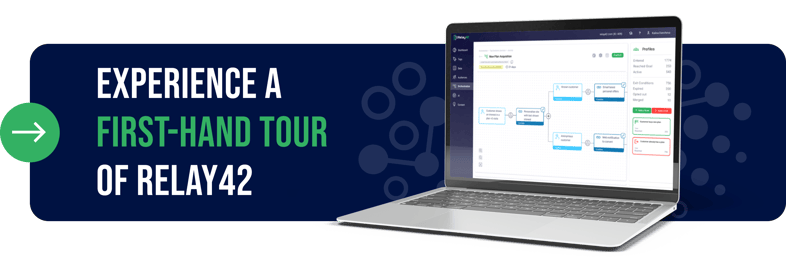What is Next Best Action and How to Use It to Evolve Customer Experiences?
by Anthony Botibol on 30.4.2024

Next Best Action (also known as best next action, next best activity or recommended action), is a customer-centric approach to marketing that considers multiple different actions that could be taken for a specific customer and then decides on the best one to provide.
Moreover, Next Best Action commonly requires the need for automated self-learning AI to make a decision in real-time that will improve the chances of a conversion at the live moment that a customer is making a purchase decision.
The Next Best Action (to deliver the relevant offer, proposition or service) is determined through a combination of the customer's interests and behaviors as well as the objectives of the business.
For example, as a marketing team your simple objective might be to sell a specific product or product range during an offer window, but must be balanced with how the customer likes to be contacted and the likelihood for them to have an interest in that product or product range. By only presenting the offer to customers that are deemed to be showing interest, and in the channels they prefer, you are able to maximize conversions while also respecting the fact that other customers would not appreciate the offer.
When implemented correctly, Next Best Action can become a continuous way of engaging with customers in the right way, with the most relevant content or offer, using the right channels. Most importantly, it is an automated process that is self-optimizing to ensure it improves over time, which means that it requires very little manual intervention, and becomes entirely 'customer-centric'.
Now, Next Best Action requires a lot of planning, requires a lot of good data and potentially some knowledge and skills that you don’t already have in place. More practically, you will find that it requires a lot of time to implement, but as we've just mentioned, it then will require less manual intervention in the longer term, and therefore you will get that time back in the end. Due to this, no business will typically jump straight into Next Best Action, but almost all companies have some form of basic campaign management and automation capabilities to build upon, and will undertake a transformational journey towards a fully-fledged Next Best Action strategy powered by AI models.
How the availability of AI is creating new opportunities for Next Best Action
In truth, Next Best Action is not a new ambition for marketers however until recently AI was either a ‘black box’ magical solution that required a lot of trust that compliance would become a bottleneck to implementation into a customer marketing program, or required data science skills that the majority of marketers do not have, however, with 2023 being the Year of AI, the explosion of usable AI by 'everyday marketers' is now at a stage that brings the potential for Next Best Action marketing back to the forefront.
Relay42 uniquely combines our Customer Data Platform with our neural network AI, and journey orchestration to provide a toolkit that enables everyday marketers to evolve from basic forms of marketing automation towards Next Best Action, and towards a utopia of 'Customer Journey Optimization' (this is actually one step beyond Next Best Action but adds the ability to arbitrate on how journeys are evolving over time).

The Evolution of Next Best Action
Stage 1: Campaign Management
This stage is where the majority of marketers are in their maturity when they speak to Relay42, and typically use marketing automation and campaign execution tools to deliver offers, content, and experiences to their customers.
Using your email marketing platform is a good example – you create an audience or list of customers, design a creative, and then execute the campaign. You may also use email automation to deliver subsequent emails depending on their reaction to the initial email message.
Campaign Management is usually ‘offer-centric’ and ‘process driven’ rather than a ‘customer-centric’ focus because it is a pre-determined set of rules based on your marketing goal.
Generally, we identify a lot of manual intervention by the marketing, IT, or data analytics teams in this approach, but is also the least complex method of marketing, and therefore is why most marketers sit in this world of basic campaign management.
Stage 2: Campaign Optimization
This is the first evolution that marketers look to aspire to from basic campaign management. Ultimately, this is where the marketing team starts to bring analysis, personalization, and additional marketing channels into their campaigns. Most marketers use email marketing as a core channel but will start to bring in other channels like SMS, mobile app experiences, advertising channels, direct mail, live chat, or call center activities.
With some degree of integration or ETL processes between these tools, marketers at this stage are ensuring that their customers can choose the channels they prefer to act upon your offers, and with some cross-channel attribution in place, marketers will typically see a small increase in conversion rates for every extra channel used in a multi-channel campaign.
Campaign optimization is still however 'offer centric' and 'process driven', but the addition of deeper analysis, better personalization, and the uplift from utilizing additional channels puts these marketers on their first step towards some level of customer-centricity.
There can still be a lot of manual intervention in this approach to move data between platforms, but the personalization tools you need to invest in, and any integrations that they have, will ensure that the manual intervention can be reduced.
Stage 3: Predictive Optimization
This is where you start to put customer analytics, AI, or predictive modeling truly at the heart of your campaigns, both in terms of the segments of customers you select for each campaign, as well as an automated way to use campaign results to optimize subsequent campaigns. This is typically the biggest maturity step for marketers to take on their route to 'Next Best Action' and 'Customer Journey Optimization'.
This is because it involves statistical modeling tactics and a deeper understanding of data analytical techniques, which are not common skills found in most marketers. Relay42’s proprietary AI technology empowers everyday marketers with the data, analytics, and predictions to make this evolution easier, and through AI model creation wizards it enables marketers to build AI models to make accurate real-time decisions in the digital moments that matter.
This stage is still 'offer-centric' but it starts to radically reduce the need for your own empirical knowledge and manual intervention, and start to fully rely on statistics and predictive AI to do all the heavy lifting. When you hear about ‘data-driven organizations’ this is the stage that ensures you qualify as one!
Stage 4: Next Best Action
This is the logical next step for marketers that are comfortable with the use of predictive AI and modeling, but is also significantly a paradigm shift from being 'product-centric' to becoming 'customer-centric'. At this stage, neural network AI takes your predictive modeling to a new level through the introduction of ‘self-learning’.
What this means is that your AI models can start to improve their own performance and accuracy. For example, once you build a predictive AI model to understand what channel a customer is most likely to respond to, as these campaigns execute and responses flow back into the model, the response data will start to fine-tune how they work.
Next Best Action is not necessarily about knowing the best product or message to serve up to a customer, but importantly when to offer it and how to communicate it. It is 'customer-centric' because it is using the customers’ own behaviors and events to choose what to serve to them, rather than the marketer’s decision.
Stage 5: Customer Journey Optimization
This is the aspirational goal of all marketers and the utopia for any organization looking to become fully 'customer-centric' delivering omnichannel personalized experiences at a huge scale.
Customer journey optimization is a higher-order capability than Next Best Action because it takes into account the fact that not all offers, products, services, and conversations are relevant at all times. Importantly, it allows for arbitration across several potentially competing recommendations to a single customer profile, combining them where relevant, or overruling some recommendations where not.
This is a complex and arduous stage to achieve, which combines many self-learning AI models for various tactics. For example, you may have models specifically created for acquisition, which will differ from your churn and reactivation models designed to reduce the loss of customers. However, once realized, this stage can create a fully automated omnichannel customer experience that appears effortless and relevant for your customers, and for your internal marketing team it hugely reduces the need for manual intervention and starts to change the skills and capabilities of your marketing team.
The use of journey orchestration to arbitrate your Next Best Action models also allows the marketing team to run experiments at journey steps to continuously improve the overall customer experience and/or pivot to new strategies when required. This is a world away from basic campaign management that requires a unique suite of technology, data, skills, processes, and culture to achieve it.
Utilizing Relay42 and AI for Next Best Action Marketing
Relay42’s Journey AI enables marketing teams, data scientists, and engineering teams to work collaboratively with either the proprietary AI technology within Relay42, use externally built models based on Relay42’s unified customer data store, or a combination of both. Whichever models are used, these can be injected into the Relay42 customer journey engine to dynamically choose the right channel(s), alter the experience that the customer receives, remove waste in your media budgets and, as customers interact with you time and again, the AI models can optimize to continuously improve performance. Every Relay42 customer receives a team of strategists to work closely with the various teams and departments in the business to help move from basic forms of campaign management along a journey towards fully automated and self-learning journeys across all channels and customer lifecycle stages.
If you’d like to speak to one of our strategists about how Relay42 can help you towards AI-based customer journeys then Request a Demo and a member of the team will get back to you to arrange the best time for a call.
You May Also Like
These Related Stories

Why Marketers Should Replace Traditional Segmentation Models with Predictive AI

3 Digital Marketing Trends You Need to Watch Out For In 2025


